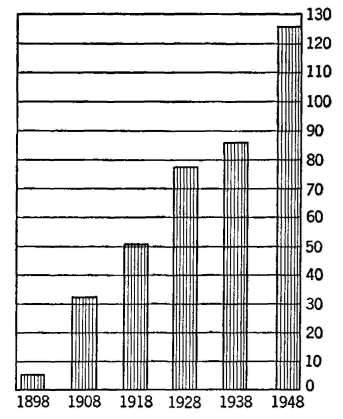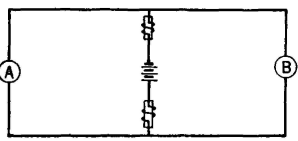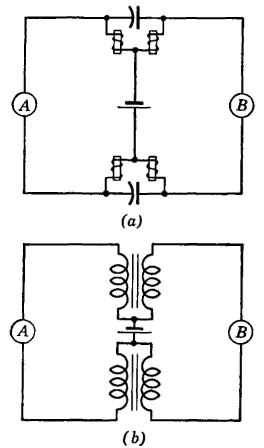| Electrical Communication is a free textbook on the basics of communication technology. See the editorial for more information.... |

|

Home  Telephone Exchange Service and Systems Telephone Exchange Service and Systems  Common-Battery Connections Common-Battery Connections |
|||||||






|
|||||||
Common-Battery ConnectionsAs explained in the discussions accompanying Figs. 14 and 16, direct current is supplied from the central-office common battery to the transmitters of the telephone sets. If the cord circuits of these two figures are examined, it will be observed that the methods of connecting to the common battery are different.
The simplest method of connecting several telephone sets to a common battery is shown in Fig. 19. The inductors (choke, or retard, coils) offer low resistance to the flow of direct current to transmitters A and B. However, they present high impedance to the alternating speech currents which, therefore, flow through the telephone sets and are not short circuited by the common battery. This method is sometimes used in interphone systems for offices, etc. Often, only one inductor is used, in which event the circuit is unbalanced.
The common-battery connections of Figs. 14 and 16 are shown in Fig. 20. These are more widely used, particularly the transformer, or repeat-ing-coil, method. A simple direct-current analysis will show that Fig. 19 is a series-parallel combination and that the resistance of each circuit affects the amount of transmitter current that flows to the other. Such an arrangement is, therefore, suitable only when the resistances of the two circuits that are connected are approximately the same. If the internal resistance of the common battery is negligible, and usually it is, then with the connections of Fig. 20 the resistance of one circuit does not affect the direct current that flows to the transmitter of the other.
|
|||||||
Home  Telephone Exchange Service and Systems Telephone Exchange Service and Systems  Common-Battery Connections Common-Battery Connections |
|||||||
Last Update: 2011-05-30




